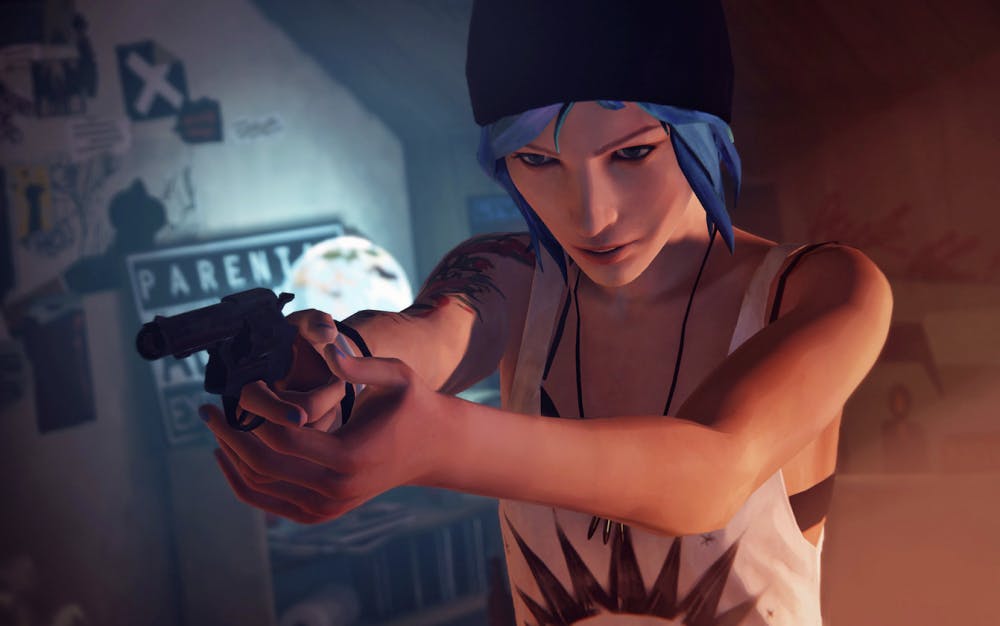Dontnod Entertainment’s first act of Life is Strange grips players with main protagonist, obscure story choices.
Score: 3.5/5
“Life is Strange” is exactly that: strange.
In about three hours of the first installment, one of the five scheduled for this year, players will dump paint on a pompous, preppy girl, witness a high school security guard harass a student and repeatedly rewind conversations.
For what reason? Your guess is as good as mine.
French developer Dontnod Entertainment and publisher Square Enix are crafting an episodic and interactive-drama to portray the turbulent life of Max Caulfield, who suffers from an atypical case of teenage angst. The first episode of “Life is Strange” adequately preps the stage for its future installments.
That is, if the developers can tie up some loose ends.
Story
Narrative is the core element to “Life is Strange.”
The main protagonist, Max, is a high school senior studying photography who returns to her hometown of Arcadia Bay, Oregon after a five-year hiatus from Seattle.
The recent disappearance of a Blackwell Academy student causes Max and her friends, Warren and Chloe, to try and unearth the secrets surrounding Arcadia Bay during the episode.
Dontnod Entertainment engrosses players into an atmospheric environment filled with mystery and paradox through Max’s ability to rewind time and replay moments as they’re occurring. I don’t want to spoil anything, but the first chapter just drops players into this world and doesn’t exactly explain itself fully.
That’s totally fine.
“Life is Strange” treads on the obscurity and wants players to be methodical in their choices. It’s clear the developers have constructed a linear story for their sensitive protagonist but want the players to think of repercussions and choices — regardless of how miniscule or grand.
For a new IP, “Life is Strange” takes about a full hour to find its bearings. Max initially wakes up amidst a rainy storm in Arcadia Bay, as a colossal tornado can be seen inching toward the coastal town. Before coming to grips with the scene before her, Max suddenly wakes up in class and is completely muddled by her vision. From there, Max can interact with classmates within the halls until realizing her gift: She can rewind time and redo her prior mistakes.
This leads to some intriguing decisions players can make as Max, despite the combination of two tired formulas: the usage of time-manipulation and split-minute decisions.
In games like “Prince of Persia” and “Braid,” the idea of time-control is used to save the player from his or her death. In “Life is Strange,” however, the ability to rewind time is to juggle moral dilemmas. Do you want Max to save her own skin and watch her friend get scolded by her father? Or would you rather take the blame for something you didn’t do?
Rewinding time gives players options to choose what outcome they want, but Dontnod allows players to see both sides of an outcome.
It’s something that creates a grey ambiguity to “Life is Strange” and I’m hopeful these decisions will lead to something substantive. From what I can tell in the first episode, every action matters.
In terms of characters, Max is relatively dynamic.
Like Lara Croft from “Tomb Raider,” Jodie from “Beyond Two Souls” and Kaitlin from “Gone Home,” female protagonists in video games are refreshing and progressive.
Game developers have been abysmal in terms of casting women in lead roles and it’s nice to see Max show sensitivity, fortitude and sincerity — something lacking in most games.
As a negative, some stereotypical roles can be hindering to the story. Bullies still wear black t-shirts with skulls on them, cheerleaders are blond, egotistical snobs and every introvert is feeble and weak-looking.
Some of the characters Max meets are relatively forgettable and feel somewhat shallow. Unlike Rockstar’s “Bully” in 2007, “Life is Strange” doesn’t really nail the notion that “every student is unique and different.”
Gameplay
In terms of gameplay, “Life is Strange” is inconsistent.
Players control Max in third person, which isn’t a problem, but some glitches can be seen throughout time traversing Arcadia Bay.
At one point, a squirrel NPC could be seen glitching through items placed on Blackwell’s campus and the lip-syncing is horrendous. There are games on Playstation 2 that have better lip-syncing than what Dontnod created in Act One.
What Dontnod Entertainment did well is blend gorgeous scenery into the background as players walk through Blackwell Academy.
“Life is Strange’s” art style is a beautiful mesh of “Gone Home” and color palettes that match the Northwestern United States.
Character models look sharp, but more-impressively, varied.
Despite some meaningless conversations and generalizations of the student body, Dontnod Entertainment does a fantastic job diversifying the character models seen throughout the campus grounds.
Some players are large and round, some are plump and curvy and others are well built with skinny legs. It’s a nice touch.
In terms of choices, nothing is too earth shattering at first glance. Even though you can rewind and redo your choices, the ability to see both outcomes does create feelings of commitment and justification. You’ve seen what happens when you do either action, but which one is truly the better decision? It’s a lot harder than you think.
Final Verdict
It’s hard to articulate the opening act of “Life is Strange.” It hasn’t completely found its footing yet, but it is definitely a must-play for those looking for a narrative experience.
Luke O’Roark is a sophomore studying journalism and a staff writer at The Post. Email him at lr514812@ohio.edu or find him on Twitter @Lukeoroark.






